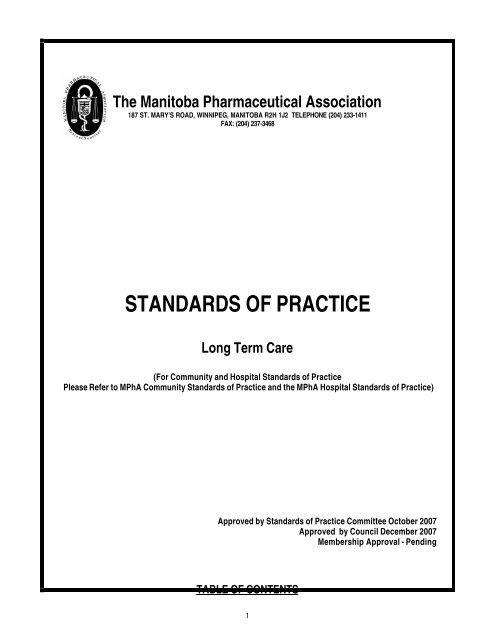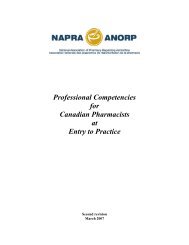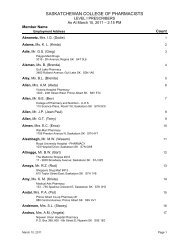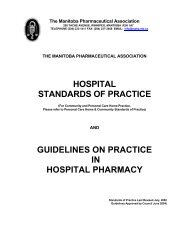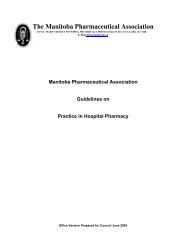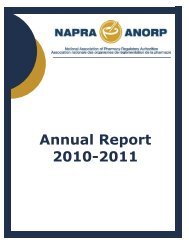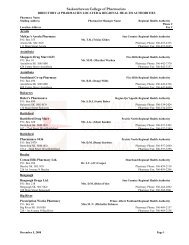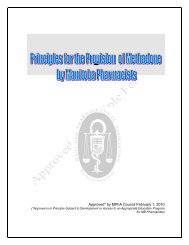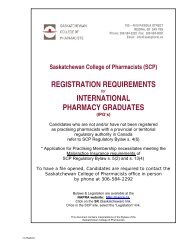STANDARDS OF PRACTICE - NAPRA
STANDARDS OF PRACTICE - NAPRA
STANDARDS OF PRACTICE - NAPRA
You also want an ePaper? Increase the reach of your titles
YUMPU automatically turns print PDFs into web optimized ePapers that Google loves.
The Manitoba Pharmaceutical Association<br />
187 ST. MARY'S ROAD, WINNIPEG, MANITOBA R2H 1J2 TELEPHONE (204) 233-1411<br />
FAX: (204) 237-3468<br />
<strong>STANDARDS</strong> <strong>OF</strong> <strong>PRACTICE</strong><br />
Long Term Care<br />
(For Community and Hospital Standards of Practice<br />
Please Refer to MPhA Community Standards of Practice and the MPhA Hospital Standards of Practice)<br />
Approved by Standards of Practice Committee October 2007<br />
Approved by Council December 2007<br />
Membership Approval - Pending<br />
TABLE <strong>OF</strong> CONTENTS<br />
1
1. DRUG DISTRIBUTION ............................................................4<br />
A. Purchasing, Receiving and Storage 4<br />
B. Distribution 4<br />
C. Disposal 5<br />
D. DPIN (Drug Programs Information Network) 5<br />
E. New Prescriptions 6<br />
F. Verbal Orders by Nurses 6<br />
G. Refill Prescriptions 6<br />
H. Narcotic/Controlled Prescriptions 7<br />
I. Leave of Absence/Pass Medications 7<br />
J. Controlled Dose/Compliance Packaging<br />
8<br />
K. Prescription Labelling<br />
9<br />
L. Expired Medication 9<br />
M. Drug Storage<br />
9<br />
N. Delivery 10<br />
O. Returned Medications<br />
10<br />
P. Re-Use of Medications<br />
10<br />
Q. Drug Recall Procedures 10<br />
R. Medication Room Inspections<br />
10<br />
S. Ward Stock (Stock) Medications 11<br />
T. Medication Administration 11<br />
U. Medication Reviews 11<br />
V. Herbal Medications 12<br />
W. Pre-packaging 12<br />
2. RESIDENT COUNSELLING.......................................................13<br />
3. DRUG INFORMATION SERVICE ...............................................14<br />
4. FORMULARY ...........................................................................15<br />
5. HOURS <strong>OF</strong> PHARMACY SERVICE ............................................16<br />
6. POLICIES AND PROCEDURE MANUAL ....................................17<br />
7. LEGAL AND ETHICAL..............................................................18<br />
8. EXTEMPORANEOUS COMPOUNDING......................................20<br />
9. MEDICATION ERRORS ............................................................20<br />
Appendix One: Sample Quarterly Medication Review Process<br />
Appendix Two: Sample Guideline for a Quality Quarterly Medication Review Process<br />
2
Appendix Three: Sample Quarterly Medical Review Physician Remuneration Claim Form<br />
3
Standard 1:<br />
EVERY PHARMACIST MANAGER SHALL BE RESPONSIBLE FOR THE PURCHASING, RECEIVING, STORAGE,<br />
DISTRIBUTION AND DISPOSAL <strong>OF</strong> DRUGS PRODUCTS AND MEDICAL DEVICES IN THE PHARMACY.<br />
Standard 2:<br />
A PHARMACIST SHALL PROMOTE THE SAFE AND EFFECTIVE USE <strong>OF</strong> MEDICATION BY EDUCATING RESIDENTS ABOUT<br />
THEIR DRUG THERAPY.<br />
Standard 3:<br />
A PHARMACIST SHALL PROVIDE ACCURATE, UNBIASED, PERTINENT DRUG INFORMATION.<br />
Standard 4:<br />
10(1) A PHARMACIST SHALL <strong>PRACTICE</strong> IN ACCORDANCE WITH A FORMULARY APPROVED UNDER THE ACT.<br />
10(2) A PHARMACIST WHO <strong>PRACTICE</strong>S IN A HEALTH CARE FACILITY SHALL <strong>PRACTICE</strong> IN ACCORDANCE WITH A<br />
FORMULARY ESTABLISHED AND APPROVED BY THE FACILITY.<br />
Standard 5:<br />
A PHARMACY MANAGER SHALL ENSURE THAT THE PHARMACY HOURS MEET THE NEEDS <strong>OF</strong> THE COMMUNITY,<br />
HOSPITAL AND INSTITUTION ON A 24 HOUR BASIS WHERE IT IS PRACTICAL AND NECESSARY TO DO SO.<br />
Standard 6:<br />
A PHARMACY MANAGER SHALL ESTABLISH CURRENT WRITTEN POLICIES AND PROCEDURES TO PROVIDE<br />
PHARMACY STAFF WITH CLEAR DIRECTION ON THE SCOPE AND LIMITATIONS <strong>OF</strong> THEIR FUNCTIONS AND<br />
RESPONSIBILITIES<br />
Standard 7:<br />
THE PHARMACY SHALL ABIDE BY THE LAWS AND ETHICAL PRINCIPLES GOVERNING THE PR<strong>OF</strong>ESSION <strong>OF</strong> PHARMACY<br />
TO ENSURE A HIGH LEVEL <strong>OF</strong> RESIDENT CARE.<br />
Standard 8:<br />
A PHARMACIST SHALL BE RESPONSIBLE FOR ALL EXTEMPORANEOUS COMPOUNDING WHICH SHALL BE DONE<br />
ACCORDING TO ESTABLISHED PROCEDURES AND LEGAL REQUIREMENTS.<br />
Standard 9:<br />
A PHARMACIST SHALL EXPEDITIOUSLY CORRECT AND PROPERLY DOCUMENT ALL DISPENSING ERRORS, INCIDENTS<br />
AND DISCREPANCIES.<br />
Standard 10<br />
A PHARMACIST SHALL COMPLY WITH THE REQUIREMENTS ESTABLISHED BY MANITOBA HEALTH IN THE PERSONAL<br />
CARE HOMES <strong>STANDARDS</strong> REGULATION, AUGUST 1, 2005<br />
4
STANDARD #1 DRUG DISTRIBUTION<br />
EVERY PHARMACIST MANAGER SHALL BE RESPONSIBLE FOR THE PURCHASING, RECEIVING,<br />
STORAGE, DISTRIBUTION AND DISPOSAL <strong>OF</strong> DRUGS PRODUCTS AND MEDICAL DEVICES IN THE<br />
PHARMACY.<br />
Long Term Care Interpretation:<br />
Pharmacy support personnel may be utilized to reduce the professional time committed to the mechanics<br />
of the drug distribution service without reducing the professional and legal control.<br />
A. Purchasing, Receiving and Storage<br />
1.1. As drugs are received for the pharmacy or pharmacy department, they shall be handled in the<br />
following manner:<br />
1.1.1. All products regulated by the Controlled Drugs and Substances Act (eg narcotic,<br />
controlled, and targeted substances etc) shall be delivered to the dispensary directly<br />
or, where applicable, to the receiving area and subsequently delivered to the<br />
dispensary forthwith;<br />
1.1.2. The pharmacist manager shall be responsible to ensure established policy and<br />
procedures provide for the security of all medication received during the time elapsed<br />
from the actual receiving until the medication is stored properly by dispensary staff;<br />
1.1.3. The pharmacist manager shall be responsible to ensure established policy and<br />
procedures provide for the safe and secure storage of drugs when storage within the<br />
dispensary is not possible.<br />
1.2. All drugs and health care products shall be stored under proper conditions of sanitation,<br />
temperature, light, humidity, ventilation and security.<br />
1.3. All expired drugs and health care products must be removed from the areas of sale as<br />
described in federal legislation, the Pharmaceutical Act, the regulations of the Pharmaceutical<br />
Act, Standards of Practice and Practice Directives. Products offered for sale shall be checked<br />
as often as necessary in order to comply with this section.<br />
B. Distribution<br />
1.4. For any prescription medication, or <strong>NAPRA</strong> Schedule II or III and other regulated nonprescription<br />
medication to be provided to the resident by delivery, the pharmacist must:<br />
1.4.1. attach any pertinent auxiliary labels to the container; and/or ensure auxiliary instructions<br />
are included on the MAR;<br />
1.4.2. include additional warning labels or bulletins should there be any drug strength or<br />
dosage substitution change and/or any generic substitution;<br />
1.4.3. establish policy to ensure the proper storage and environmental conditions for<br />
medication that are being delivered and, in default of the delivery, that the medication is<br />
returned to the pharmacy the next business day;<br />
1.4.4. include printed drug information plus contact pharmacy information, in addition to<br />
counselling to the resident or nursing where the product is new or unusual to facilitate<br />
5
staff and resident education if required;<br />
1.5. For any prescription to be provided for the resident by mail service or courier, the pharmacist must:<br />
C. Disposal<br />
1.5.1. use a courier or postal method or where not available, the best available method that<br />
has available signed proof of delivery including narcotic, controlled and targeted<br />
substance prescriptions and retain the shipping receipt information for 60 days;<br />
1.5.2. attach any pertinent auxiliary labels to the dispensed container and/or ensure auxiliary<br />
instructions are included on the MAR;<br />
1.5.3. include additional warning labels or other notation should there be any drug strength, or<br />
dosage substitution change and/or change of brand or generic substitution provided;<br />
1.5.4. include printed drug information where product is new or unusual to facilitate staff and<br />
resident education if required.<br />
1.6. All drugs and medical devices for disposal shall be rendered unusable and disposed of in<br />
accordance with federal and provincial laws, and regulations relating to hazardous waste<br />
materials.<br />
D. DPIN (Drug Programs Information Network)<br />
1.7. The following must occur under the Drug Programs Information Network (DPIN):<br />
1.7.1. "Days Supply" field must be filled in the DPIN system. Where dosages are suffixed by<br />
"prn" or indicate "ut dict", the day’s supply should be calculated using professional<br />
judgement or calculated using the maximum dose resulting in a lower number of days<br />
supply;<br />
1.7.2. When accessing the DPIN resident profile, as permitted under the Pharmaceutical Act of<br />
Manitoba and privacy legislation, without the provision of a prescription, the pharmacist<br />
must:<br />
1.7.2.1. confirm the identity of the person requesting the access and their authority to do<br />
so;<br />
1.7.2.2. clarify the inquiry with respect to resident care;<br />
1.7.2.3. document the name of the person and reason for inquiry in a readily retrievable<br />
manner;<br />
1.7.2.4. retain this information for a period of 2 years.<br />
1.7.3. Where critical resident care codes, MY (duplicate drug other pharmacy) or MZ (duplicate therapy<br />
other pharmacy), appear, either separately or in addition to other codes, from the DPIN<br />
with the filling of a prescription, the pharmacist must intervene and document the<br />
interventions on the DPIN and the resident record in the pharmacy.<br />
1.7.4. Where all other resident care codes appear from the DPIN with the filling of a<br />
prescription, the pharmacist shall use professional judgement in the review, intervention<br />
and documentation of the response. If the review reveals that an intervention is critical<br />
to resident care, or results in a change in the prescription, the pharmacist shall<br />
document the response in the DPIN and the resident record in the pharmacy.<br />
* Pharmacies based in hospitals may not have access to DPIN adjudication and may be exempt.<br />
E. New Prescriptions<br />
6
1.8. When original or faxed prescriptions are filed, the resident location is not required provided all<br />
prescriptions are filed together for a particular home. All prescriptions must be filed in a<br />
consistent manner, alphabetical and/or chronologically, that would facilitate ready retrieval.<br />
1.8.1. All information required by 18(1) of the Pharmaceuticals Regulations to The<br />
Pharmaceutical Act must be recorded and readily available as hard copy or software<br />
record.<br />
1.8.2. The following minimum information must be documented on the original or faxed<br />
prescription:<br />
1.8.2.1. resident name and one other identifier (e.g. PHIN, date of birth, facility & room<br />
number);<br />
1.8.2.2. drug, strength and quantity dispensed;<br />
1.8.2.3. date dispensed;<br />
1.8.2.4. pharmacist initials.<br />
1.8.3. Only original or faxed prescriptions, not NCR copies are to be sent to the pharmacy<br />
(hospital pharmacies exempt).<br />
1.8.4. All original prescriptions for sales reportable narcotics must be matched to facsimile<br />
prescriptions as these drugs are not covered under the Facsimile Transmission of<br />
Prescriptions Joint Statement.<br />
1.8.5. When prescriptions are filled from ward stock, bulk, or in-house DRUGS, a clear notation<br />
WS (ward-stock) or NF (not filled) or LOG should appear beside the entry to reflect that<br />
the prescription has been “logged”.<br />
1.8.6. The direction on the MAR should indicate “use stock” or “use in-house drug” as<br />
appropriate.<br />
1.8.7. All prescription forms must have a statement indicating the order is to be continued until<br />
next medication review or unless otherwise specified.<br />
1.8.8. All prescription forms may indicate “generic substitution authorized unless otherwise<br />
specified.”<br />
1.8.9. Resident medication profiles must be reviewed at a minimum, prior to dispensing of all<br />
new medications or discontinuation of a medication.<br />
F. Verbal Orders by Nurses [Not Including RN (EP’s) who are Prescribers Themsleves]<br />
1.9. A pharmacist may dispense a prescription pursuant only to an order from a prescriber. All<br />
telephone prescriptions communicated by a prescriber, and transcribed or transmitted by a<br />
nurse on behalf of the prescriber, and faxed to pharmacy must be co-signed by the prescriber<br />
on his/her next visit and sent immediately to the pharmacy within fourteen days of the original<br />
order.<br />
Verbal orders within the PCH should be discouraged.<br />
The signed prescription must be attached to the original prescription prior to filing (usually the fax<br />
or NCR copy).<br />
G. Refill Prescriptions<br />
1.10 Any time there is a change in prescriber, all computer and hard copy records must be able to<br />
identify the authorizing prescriber of each refill.<br />
1.10.1 Medication Review sheets must contain the statement “This signature (of the prescriber)<br />
7
authorizes the provision of the medications until the next medication review or<br />
discontinuance by the prescriber.”<br />
1.10.2 Medication Review sheets must be kept for two years and filed in a readily retrievable<br />
manner, alphabetically by PCH and resident, and chronologically.<br />
1.10.3 Resident medication profiles must be reviewed prior to dispensing of all medications.<br />
1.10.4 Refills may be documented by either a logbook recording system or printed refill<br />
sheets.<br />
1.10.5 Logbook System<br />
1.10.5.1 The date, prescription number, quantity dispensed, price and handwritten initials<br />
of the dispensing pharmacist must be recorded.<br />
1.10.5.2 Logbook pages must be filed in an orderly, chronological manner, a new page<br />
for each day, or separate page (MAR) for each resident.<br />
1.10.5.3 Logbook systems using a separate page (MAR) for each resident may<br />
document controlled and/or narcotic prescriptions providing a separate<br />
hardcopy prescription is filed chronologically and numerically.<br />
1.10.5.4 Logbook records must be retained for two years.<br />
1.10.6 Refill Record<br />
1.10.6.1 Daily refill records cannot include new prescriptions and must indicate the date,<br />
prescription number, quantity dispensed and price of each refill.<br />
1.10.6.2 Packing slips may serve as the refill record and may include new and refill<br />
prescriptions.<br />
1.10.6.3 Refill records must be signed and dated, line by line or in batches by, the<br />
dispensing pharmacist.<br />
1.10.6.4 Refill records are to be filed by home and then date, or by date and then home.<br />
1.10.6.5 Refill record system applies to all prescribed medication but not controlled or<br />
narcotic prescriptions.<br />
1.10.6.6 Refill records must be retained for two years.<br />
H. Narcotic/Controlled Prescriptions<br />
1.11 Narcotic/Controlled prescriptions supplied from in house drug box should indicate such in house<br />
drug stock beside the order, and filed in the narcotic file.<br />
1.11.1 Should a resident require their own supply of narcotic or controlled medication, a verbal<br />
or written order must be received as required by legislation.<br />
1.11.2 All narcotic/controlled drugs available within a PCH as an “in-house drug” or within the<br />
Stat or Emergency Box require a written Rx with specific quantities from the designated<br />
Medical Director.<br />
I. Leave of Absence/Pass Medications<br />
1.12 The pharmacy must prepare LOA medications in compliance with the labelling and packaging<br />
requirements, including child resistant containers, unless requested otherwise by the resident or<br />
their agent.<br />
1.12.1 The preparation of LOA medications by the pharmacy is only required when requested<br />
by the home. (If the home decides to provide LOA medications without informing the<br />
pharmacy, the home accepts full responsibility for packaging and labelling).<br />
8
1.12.2 The pharmacy should establish a clear process with the PCH for requesting LOA<br />
medication, which may include a request for advance information and minimum away<br />
time period.<br />
J. Controlled Dose/Compliance Packaging<br />
1.13. Medication should be dispensed in individually labelled controlled dose blister packed cards or<br />
compliance packaging. The tactile process of preparing blister packed medication must be<br />
performed in such a manner as to optimize sanitary preparation of the medication.<br />
1.14. Compliance Packaging Standards<br />
Non-compliance and medication errors can significantly impact patient care resulting in negative health<br />
consequences for the patient, increase use of limited health care resources, and increased<br />
expenditures for third party payers. Compliance packaging has been widely recognized by patients,<br />
caregivers and allied health care professionals to enhance patient compliance permit more efficient<br />
utilization of health care personnel and reduce medication incidents and discrepancies.<br />
These guidelines are directed towards pharmacy practices, which service patients within the<br />
community. However, they may also have applications in personal care home settings. The goal of<br />
these recommendations is to provide patients and care givers with consistent, user-friendly compliance<br />
packaging.<br />
1.14.1 Description of the drug appearance: The description must include the shape and colour<br />
of the dosage and may also include size, form and identifiable markings.<br />
1.14.2 The location of the description of the drug on the package: The description must appear<br />
on the package or on a label affixed to the package.<br />
1.14.3 Placement of labels: All labels must be affixed directly to the package.<br />
1.14.4 Compliance with labelling requirements: All labelling information must be in compliance<br />
with section 19(1) of the Regulations to the Pharmaceutical Act.<br />
1.14.5 Standardization of dosing time: Information must appear on the package indicating<br />
where, the individual doses of the various prescriptions are to be found on the blister<br />
package (e.g. morning, noon, evening, or at bedtime). Further, the pharmacy must have<br />
a readily retrievable recording system in place, manual or on computer, to ensure<br />
current, consistent packaging and location of doses in the package, from refill to refill of<br />
the same medication.<br />
1.14.6 Lot Number and Expiry date: In Personal Care Home practice, the lot number and expiry<br />
date must be identified on each package.<br />
1.14.7 Repackaging of returned medication: In Personal Care Home pharmacy practice,<br />
medication may be repackaged once for a second use if the medication is packaged<br />
one drug per pouch/package. If the pouch/package contained more than one drug, no<br />
repackaging may be undertaken.<br />
1.14.8 Child Resistant Closures: The pharmacy is responsible for making sure the Personal<br />
Care Home is aware that compliance packaging is not child resistant and that permission<br />
from the patient or caregiver must be documented and kept on file when medication is<br />
supplied to a resident who temporarily leaves the facility for the community (e.g. social<br />
leave).<br />
1.14.9 Type of Packaging: The pharmacy must not dispense in compliance packaging any<br />
drug which is not appropriate for such packaging, according to manufacturer’s directions,<br />
compendia sources or the pharmacist’s professional judgment. Policy must be<br />
established for the appropriate packaging of medication where physical or chemical<br />
9
form, light sensitivity, therapeutic incompatibility or risk of interaction with another drug in<br />
the compartment, could potentially reduce the effectiveness of the medication. When<br />
using heat-sealing systems, care must be taken not to disrupt the integrity of the dosage<br />
form.<br />
1.14.10 Placing doses in package compartments for sealing: Attention must be made to proper<br />
hygiene when placing the dosages in the blisters on the compliance packaging<br />
packages. Ongoing hand washing with a hypoallergenic soap, the use of rubber gloves<br />
and prevention of cross contamination, for patients with known anaphylactic responses to<br />
certain medications, must all be addressed in established policy.<br />
1.14.11 Disposal of Compliance Packaging: The pharmacy must dispose of any returned<br />
labelled compliance packaging in such a manner as to ensure patient confidentiality in<br />
compliance with the personal health Information Act.<br />
K. Prescription Labelling<br />
1.15. Section 19 to the Pharmaceutical Act Regulations must be adhered as well as:<br />
1.15.1. auxiliary labelling as required.<br />
1.15.2. route of administration (if other than oral).<br />
1.15.3. maintaining pharmacy identification.<br />
1.15.4. Pharmacy identification (name, address, and phone) may be located on the external<br />
pouch porter for an automated distribution system, as well as the resident name, room<br />
number, physician and picture.<br />
1.15.5. Pharmacy identification (name and phone) must be located on the internal pouch (i.e.<br />
each pouch).<br />
1.15.6. small containers (i.e. ophthalmic preparations) must be placed in a larger container<br />
bearing a label with all the necessary information - the small containers must be labelled<br />
with:<br />
1.15.6.1. Rx number<br />
1.15.6.2. resident name<br />
1.15.6.3. drug, drug strength, and route of administration (if other than oral)<br />
L. Expired Medication<br />
1.16 Expired products must be removed from the areas of sale as described in Section 26 of the<br />
Regulations of the Pharmaceutical Act. Products offered for sale shall be checked as often as<br />
necessary in order to comply with this section.<br />
1.16.1 Product will be provided to the PCH for emergency/stat, stock, extra-dose binder or inhouse<br />
drug use with the best expiry date.<br />
1.16.2 Product will be dispensed to a resident for PRN use with the best expiry date.<br />
1.16.3 A process must be in place to track expiry dates and lot numbers on dispensed<br />
medication.<br />
M. Drug Storage<br />
1.17 All drugs shall be stored under proper conditions of sanitation, temperature, light, humidity,<br />
10
ventilation and security, within the pharmacy. Recommendations and a process for auditing and<br />
monitoring the above noted conditions in the PCH shall be established.<br />
N. Delivery<br />
1.18 Medication shall be securely delivered to the personal care home from the pharmacy with the<br />
least amount of delay<br />
1.18.2 All parts of the transportation system shall protect the medications from pilferage,<br />
breakage and deterioration due to extreme environment variation (e.g. temperature,<br />
humidity).<br />
1.18.3 A chain of signature must be established and maintained when prescriptions are<br />
transported by non pharmacy staff.<br />
1.18.4 The delivery by non pharmacy staff must be taken directly to a nurse in the PCH and a<br />
signed record of the receipt shall be kept.<br />
1.18.5 If the delivery cannot be made or is not accepted, the medication must be returned to<br />
the pharmacy within the next business day.<br />
O. Returned Medications<br />
1.19 Medications dispensed for administration, but not used, shall be returned to the pharmacy.<br />
1.19.1 Procedures for returning drugs to stock shall be instituted. These shall include the<br />
following considerations:<br />
1.19.1.1 integrity of returned drug package,<br />
1.19.1.2 proper storage of the drug on the nursing care station,<br />
1.19.1.3 the resident has not been in possession of the drug,<br />
1.19.1.4 medications which have been packaged together, and without expiry date or lot<br />
number, shall not be returned to stock.<br />
P. Re-Use of Medications<br />
1.20 Any liquid, topical or injectable preparations whose seal has been broken cannot be re-used.<br />
Q. Drug Recall Procedures<br />
1.21 On drug recall occasion, all stock of the medication, in the particular form and strength, must be<br />
pulled from use in the PCH and pharmacy, and replaced with product not subject to the recall.<br />
The pharmacy shall ensure that a process exists and is clearly documented with the PCH.<br />
R. Medication Room Inspections<br />
1.22 Pharmacists or pharmacy technicians shall inspect all drug storage areas regularly, at least every<br />
three to four months.<br />
1.22.1. A written record shall be maintained by the pharmacy and a copy distributed to the PCH.<br />
1.22.2 The inspection should include but not be limited to the following:<br />
i) medication shall be stored securely on the ward and available to authorized<br />
personnel only,<br />
ii) narcotics and controlled drugs substances are being stored with proper measures of<br />
inventory control and security,<br />
11
iii) drugs requiring special environmental conditions for stability are properly stored and<br />
all drugs are stored under environmental conditions specified by the manufacturer’s,<br />
iv) no outdated drugs are stocked,<br />
v) drugs are not being overstocked,<br />
vi) discontinued medications are returned to the pharmacy,<br />
vii) disinfectants and drugs for external use are stored separately from internal and<br />
injectable medications,<br />
viii) resident specific medications are stored separately from stock medication,<br />
ix) drugs which may be required on an urgent or emergency basis are in adequate and<br />
proper supply, with a current list and inventory system that provides a record of use.<br />
x) in-house drugs are in sufficient supply,<br />
xi) extra dose binder process is monitored, complete, and the inventory system<br />
provides a record of use,<br />
xii) standards of neatness and cleanliness are consistent with good medication handling<br />
practices,<br />
xiii) Narcotic and controlled drugs are stored in a double lock system with proper<br />
measures of inventory control.<br />
S. Ward Stock (Stock), Emergency Drug Box, In-House Drug Box Medications (i.e. Non Patient<br />
Specific Medications)<br />
1.23 Solid oral stock medications should be provided in a controlled dose format.<br />
1.23.1 The pharmacy, in collaboration with the PCH, shall establish a list of ward stock<br />
medications and that list shall be reviewed by PCH and pharmacy at least every three<br />
years.<br />
T. Medication Administration<br />
1.24 The pharmacy provider shall advise the personal care home on a comprehensive medication<br />
administration system in terms of administering medication to the residents of the personal care<br />
home.<br />
U. Medication Reviews<br />
1.25 Medication Reviews must be done at a minimum of every three months and include nursing,<br />
pharmacist and prescriber.<br />
1.24.1. Medication reviews must be signed by the prescriber and the original signed document<br />
kept in a readily retrievable manner in the pharmacy.<br />
V. Herbal Medication<br />
1.26 Pharmacists will, to the best of their ability, ensure herbal products used by residents do not<br />
interact with prescribed medication, and if so, consult the prescriber.<br />
W. Pre-packaging<br />
1.27 A process should be in place to track medication previously packaged, to prevent its use more<br />
12
than twice.<br />
13
STANDARD #2 RESIDENT COUNSELLING<br />
A PHARMACIST SHALL PROMOTE THE SAFE AND EFFECTIVE USE <strong>OF</strong> MEDICATION BY<br />
EDUCATING RESIDENTS ABOUT THEIR DRUG THERAPY.<br />
Long Term Care Interpretation:<br />
2.1 The pharmacist is involved in providing care to residents residing within a personal care home<br />
shall promote safe and effective medication use by interacting with other healthcare<br />
professionals and family involved in the care of the resident, and where possible or requested<br />
by the resident:<br />
• providing pertinent information to PCH staff regarding possible significant interactions,<br />
and special storage requirements.<br />
• providing feedback through written report or attendance at initial and annual care<br />
conferences.<br />
• assessing indications, goals and monitoring outcomes with the healthcare team during<br />
quarterly medication reviews.<br />
• Providing in-services on new drugs, or topics requested by the PCH at least twice<br />
annually.<br />
• Documented evidence of clinical pharmacist expertise on-site in the PCH.<br />
• The pharmacist shall be available to provide staff with information regarding an individual<br />
resident's medication profile as part of their overall care plan.<br />
2.2 The pharmacist shall assist in determining whether a PCH resident is capable of selfadministering<br />
medication.<br />
2.3 The pharmacy service in co-operation with administration, medical and nursing staff (often in a<br />
PCH this is a function of P & T committee) shall be involved in developing policies on resident<br />
counselling.<br />
2.4 The pharmacist shall document the occurrence of the resident counselling and this<br />
documentation shall become a permanent record in the resident's chart.<br />
14
STANDARD #3 DRUG INFORMATION SERVICE<br />
A PHARMACIST SHALL PROVIDE ACCURATE, UNBIASED, PERTINENT DRUG INFORMATION.<br />
Long Term Care Interpretation:<br />
3.1 The pharmacy must at least have the minimum information resources as determined by Council.<br />
3.2 All drug information requests must be handled by a pharmacist, or a student or intern under the<br />
supervision of a licensed pharmacist.<br />
3.3 The pharmacist shall select from the current drug literature those additional reference sources<br />
that will meet the drug information needs of the specific area of practice.<br />
3.4 The pharmacist shall use professional expertise and judgement in processing drug information<br />
requests. This includes:<br />
3.4.1 obtaining the necessary background information so that the request is received in a<br />
complete and understandable form;<br />
3.4.2 interpreting the drug information request;<br />
3.4.3 systematically and thoroughly conducting a literature search;<br />
3.4.4 evaluating the literature in an accurate, unbiased manner;<br />
3.4.5 formulating a relevant, coherent and informative response, and<br />
3.4.6 communicating the response in a verbal and/or written form.<br />
3.5 The pharmacist should contribute to the drug literature.<br />
3.6 The pharmacist shall ensure the availability of current information on the assessment,<br />
management and the prevention of drug poisoning by referral to, or in conjunction with, or in<br />
absence of, a Poison Control Centre.<br />
3.7 The pharmacist shall be aware of more extensive sources of information and the procedures<br />
necessary to access them.<br />
3.8 Drug information services shall be available twenty-four hours a day, seven days a week. If<br />
staffing is not feasible after regular hours, drug information shall be provided by a pharmacist<br />
"on-call". Where the pharmacy service is provided by only one pharmacist and if it is necessary<br />
for that pharmacist's absence, the pharmacist must make arrangements in advance for the<br />
provisions of drug information services.<br />
3.8.1 The pharmacist shall provide specific information related to individual resident's drug<br />
related treatment in case conferences and drug review sessions.<br />
15
STANDARD #4 FORMULARY<br />
A PHARMACIST SHALL <strong>PRACTICE</strong> IN ACCORDANCE WITH A FORMULARY APPROVED UNDER THE<br />
ACT.<br />
A PHARMACIST WHO <strong>PRACTICE</strong>S IN A HEALTH CARE FACILITY SHALL <strong>PRACTICE</strong> IN ACCORDANCE<br />
WITH A FORMULARY ESTABLISHED AND APPROVED FOR THE FACILITY.<br />
Long Term Care Interpretation:<br />
4.1 The pharmacist shall have a knowledge of which products are considered interchangeable and<br />
understand the legal requirements concerning product selection according to the Manitoba Drug<br />
Benefits and Interchangeability Formulary.<br />
4.3 The pharmacist shall have a knowledge of which products are considered interchangeable and<br />
understand the legal requirements concerning product selection according to the Manitoba Drug<br />
Benefits and Interchangeability Formulary, or other approved formulary.<br />
4.4 The pharmacist shall participate in the development and management of a national, provincial,<br />
regional or facility formulary system based on both therapeutic and economic consideration of<br />
drug use.<br />
4.5 The formulary is a list of drugs approved for use in the facility.<br />
4.6 The formulary shall include a description of any relevant preparation and administration in place<br />
for the use of the drugs listed.<br />
16
STANDARD #5 HOURS <strong>OF</strong> PHARMACY SERVICE<br />
A PHARMACY MANAGER SHALL ENSURE THAT THE PHARMACY HOURS MEET THE NEEDS <strong>OF</strong><br />
THE COMMUNITY, HOSPITAL AND INSTITUTION ON A 24 HOUR BASIS WHERE IT IS PRACTICAL<br />
AND NECESSARY TO DO SO.<br />
Long Term Care Interpretation:<br />
5.1 If the requirements of an individual institute and the availability of pharmacy staff preclude the<br />
provision of a 24 hour pharmacy operation, there shall be on-call pharmacy service for urgent<br />
medications not available through the stat box and/or for information required on an urgent basis.<br />
5.2 Appropriate mediation for immediate response shall be available in the facility.<br />
5.3 When the pharmacy is closed, an authorized nurse shall obtain needed drugs from the stat box,<br />
or extra dose binder. The prescriber order shall be referred to the pharmacist for verification by<br />
a pharmacist.<br />
5.4 A record shall be kept on all withdrawals. This record shall include:<br />
• Resident name & location,<br />
• Complete description of drug product and quantity,<br />
• Signature of authorized nurse,<br />
• Date the drug is removed.<br />
17
STANDARD #6 POLICIES & PROCEDURE MANUAL<br />
A PHARMACY MANAGER SHALL ESTABLISH CURRENT WRITTEN POLICIES AND PROCEDURES TO<br />
PROVIDE PHARMACY STAFF WITH CLEAR DIRECTION ON THE SCOPE AND LIMITATIONS <strong>OF</strong><br />
THEIR FUNCTIONS AND RESPONSIBILITIES.<br />
Long Term Care Interpretation:<br />
A pharmacy providing service to a PCH must maintain two separate manuals, one specific to the<br />
pharmacists practicing in the setting, the second as a guide to other healthcare professionals practicing<br />
in the PCH site. There may be areas of overlap within each manual.<br />
A. Pharmacy In-House Policy and Procedure<br />
6.1 Written policies and procedures for pharmacy services shall guide all personnel in the<br />
performance of their duties.<br />
6.2 A comprehensive policy and procedures manual will contain information relating to the<br />
medication distribution, professional responsibilities, administrative and non dispensary<br />
operational aspects of the practice.<br />
6.3 These policies and procedures shall be updated as circumstances in the pharmacy change (e.g.<br />
change of ownership, change of manager etc.) or at a minimum of every three years. and dated<br />
to indicate the date of the last review and/or revision.<br />
6.4 All pharmacy staff shall be familiar with the manual. It is important for new staff orientation and<br />
crucial to staff development and continued competence.<br />
B. PCH Pharmacy Policy and Procedure Manual<br />
6.5 The Pharmacy Policy and Procedure manual shall be developed by pharmacists in collaboration<br />
with other health care disciplines and approved by administration (if applicable).<br />
6.6 The pharmacy shall communicate the appropriate policies and procedures necessary for the<br />
attainment of drug-use control to other departments and professional groups within the PCH.<br />
Contents should address<br />
• contact information for the pharmacy,<br />
• service objectives,<br />
• the medication system provided,<br />
• medication orders and procedures,<br />
• medication administration ,<br />
• equipment systems and supplies, including forms such as MARs, QMR, Resident<br />
Status, etc,<br />
• education and may include additional drug information,<br />
• quality assurance,<br />
• other pharmacy services,<br />
6.7 The pharmacy will be responsible for the adherence to the approved pharmacy policies and<br />
procedures throughout the institution.<br />
18
STANDARD #7 LEGAL AND ETHICAL<br />
THE PHARMACY SHALL ABIDE BY THE LAWS AND ETHICAL PRINCIPLES GOVERNING THE<br />
PR<strong>OF</strong>ESSION <strong>OF</strong> PHARMACY TO ENSURE A HIGH LEVEL <strong>OF</strong> RESIDENT CARE. A PHARMACIST<br />
SHALL <strong>PRACTICE</strong> IN A SAFE, LEGAL AND ETHICAL MANNER.<br />
Long Term Care Interpretation:<br />
7.1 The pharmacist shall meet the responsibility in this standard and will practice in accordance with<br />
the following:<br />
• Controlled Drugs and Substances Act & Regulations<br />
• Narcotic Control Regulations<br />
• Food and Drugs Act & Regulations<br />
• The Pharmaceutical Act of Manitoba, Regulations, Code of Ethics, Standards of Practice,<br />
Guidelines, Practice Directions<br />
• Prescription Drug Cost Assistance Act<br />
• Personal Health Information Act<br />
• PIPPEDA<br />
• Protection of Persons in Care Act<br />
• National Association of Pharmacy Regulatory Authorities (<strong>NAPRA</strong>) Standards of Practice<br />
• Personal Care Homes Standards Regulation, Standard 12, Pharmacy Services August 1,<br />
2005 and<br />
• All other legislated and practice regulatory requirements of pharmacy practice.<br />
A. Ethical<br />
Code of Ethics<br />
7.2 The pharmacist may exercise appropriate professional judgement in the application of the legal<br />
and ethical requirements.<br />
B. Pharmacist's Responsibility when asked to Provide a Drug that may Harm the Resident<br />
7.3 In this section, "standard of care"* means the level of professional service that a reasonably<br />
prudent pharmacist would provide in caring for the resident in order to provide reasonable<br />
protection of the resident from harm.<br />
7.4 Ethically, pharmacists are obliged to hold the health and quality-of-life of their residents to be a<br />
prime consideration in all professional interactions. The standard of care when dispensing a<br />
drug includes a duty to inform the resident of the realistic consequences of its use, and to<br />
respect resident autonomy. The pharmacist must respect the autonomy of the resident* to make<br />
decisions. This requires eliciting informed consent, where the pharmacist is satisfied that the<br />
resident* possesses sufficient information and mental capacity to understand the risks and<br />
benefits of taking a particular drug, so that the resident* may voluntarily accept or reject that<br />
particular treatment. During this process, the pharmacist is obliged to accurately disclose the<br />
material risks and benefits that are reasonably known, or can be reasonably expected under the<br />
circumstances.<br />
7.5 Should the pharmacist not be satisfied that the resident* has made an informed decision, the<br />
pharmacist may compromise respect for autonomy and exercise professional judgment in a<br />
19
manner which will reduce what the pharmacist believes might be an unsafe consequence for the<br />
resident to an acceptable level.<br />
7.6 In these instances where the pharmacist accesses the risk to the resident* to exceed the benefit,<br />
documentation of all discourse and action must occur.<br />
(*Resident or Designated Care Decision Maker)<br />
20
STANDARD #8 EXTEMPORANEOUS COMPOUNDING<br />
A PHARMACIST SHALL BE RESPONSIBLE FOR ALL EXTEMPORANEOUS COMPOUNDING WHICH<br />
SHALL BE DONE ACCORDING TO ESTABLISHED PROCEDURES AND LEGAL REQUIREMENTS.<br />
STANDARD #9 MEDICATION ERRORS<br />
A PHARMACIST SHALL EXPEDITIOUSLY CORRECT AND PROPERLY DOCUMENT ALL DISPENSING<br />
ERRORS, INCIDENTS AND DISCREPANCIES.<br />
9.1 Medications shall be prepared and dispensed according to established procedures done in an<br />
accurate, safe and in a timely manner. Failing this, the following definitions apply:<br />
• Medication incident (patient health potentially compromised),<br />
• An erroneous medication commission or omission that has been subjected upon a<br />
patient.<br />
• Medication discrepancy (patient health not compromised),<br />
• An erroneous medication commission or omission that has not been released for the<br />
patient, but would have resulted in a medication incident should it have gone<br />
undetected,<br />
• All medication discrepancies would automatically become incidents once the prepared<br />
medication has been released by the licensed pharmacy.<br />
9.2 All medication incidents are to be documented at the first available time. Discrepancies may be<br />
documented at the pharmacist’s discretion.<br />
9.2.1 All medication incidents shall be documented on a numbered pharmacy incident report<br />
form and in an incident/discrepancy pharmacy logbook. The logbook shall include at a<br />
minimum the date, prescription identity number, incident identity number and brief<br />
summary of the incident.<br />
9.2.2 Medication discrepancies may be documented in a pharmacy logbook at the<br />
pharmacist’s discretion.<br />
9.2.3 The pharmacy manager shall review the incident/discrepancy pharmacy log on a regular<br />
basis. The review shall be documented in the log and any corrective measures noted.<br />
9.2.4 The Pharmacy and Therapeutics Committee review of medication incidents should be<br />
documented as part of the error reporting process.<br />
21
Appendix One:<br />
Sample Quarterly Medication Review Process<br />
1.0 POLICY<br />
Quarterly Medication Reviews will be conducted using an interdisciplinary approach no less than<br />
quarterly (every 3 months).<br />
2.0 PURPOSE:<br />
To ensure a medication review process which promotes appropriate and effective pharmacotherapy for<br />
residents of personal care homes.<br />
3.0 PROCEDURE:<br />
3.1 The Quarterly Medication Review (QMR) will contain:<br />
• Resident Name, Date of Birth (Age) and Room Number<br />
• Physician and PCH identification<br />
• Date of Printing<br />
• Diagnoses, Allergies, and an area for notes<br />
• Product and Treatment listing, including prescription number, directions, quantity dispensed,<br />
date first dispensed, last dispensed, and cost<br />
• Column for physician to indicate continue or discontinue<br />
• Area for comment by interdisciplinary team<br />
• Area for signature and completion date for all members of team.<br />
3.2 QMR reports shall be completed for all residents each quarter.<br />
3.3 A system of responsibility for QMR completion shall be established by the Chief Nursing<br />
representative and shall include:<br />
• completion in an interdisciplinary team format which meets together for effective resident care<br />
• core interdisciplinary team consists of nursing, medicine and pharmacy consulting with resident<br />
and family. The team may also include social work, dietary, OT/PT and other disciplines.<br />
• completion within a time span of 2 weeks, from the original preparation/printing of the QMR by<br />
pharmacy to final review by the interdisciplinary team<br />
• updating/reprinting if needed before team review/physician completion<br />
• filing the QMR report chronologically in the resident record in a readily retrievable manner in the<br />
22
physician order section.<br />
3.4 The interdisciplinary Quarterly Medication Review Process should include:<br />
• reviewing all medication orders for indication, efficacy, appropriate dosage and administration<br />
• monitoring the resident for effective outcomes, in instances such as<br />
• order changes<br />
• quality of life indicators (pain / behaviour management / depression, etc)<br />
• polypharmacy<br />
• cost-effectiveness<br />
• reviewing lab values, weight/blood pressure, and cognitive status where applicable<br />
• monitoring PRN medication usage, considering discontinue order if not used in three months<br />
• a distinct focus, identified by the Pharmacy and Therapeutics Committee, completed, and<br />
evaluated for each regular QMR session, and reported to the Pharmacy and Therapeutics<br />
Committee.<br />
3.5 Pharmacy recommendations at medication regimen review shall be documented and shall form part<br />
of the resident’s health record.<br />
3.6 For physician compensation the “RHA Quarterly Medical Review” Form “B” must be completed and<br />
submitted to Manitoba Health after completion of review.<br />
23
Appendix Two:<br />
Sample Guideline for a Quality Quarterly Medication Review Process:<br />
Pr<br />
ocedu<br />
re<br />
PURPOSE:<br />
To ensure a quality medication review process.<br />
Guideline for a Quality Quarterly<br />
Medication Review Process<br />
Approval:<br />
PCH Pharmacy Services Advisory Council<br />
Date:<br />
24<br />
Policy<br />
Number<br />
Page:<br />
Department:<br />
WRHA PCH Program<br />
Supercedes:<br />
New<br />
PROCEDURE:<br />
1. Quarterly Medication Review reports shall be completed for all residents each quarter, with no more than 105<br />
days between completion of reports.<br />
2. A system of responsibility for Quarterly Medication Review completion shall be established and should<br />
include:<br />
• completion in an interdisciplinary team format<br />
• completion within a time span of 2 weeks, from the original preparation/printing of the QMR by pharmacy<br />
to final review by the interdisciplinary team<br />
• updating/reprinting if needed before team review/physician completion<br />
• filing the QMR report chronologically in the resident record in a readily retrievable manner in the<br />
physician order section<br />
3. The interdisciplinary Quarterly Medication Review Process should include:<br />
• the review and evaluation of medication orders<br />
• monitoring the resident for effective outcomes ( in instances of but not exclusively, order changes, pain<br />
/behaviour management, polypharmacy, and cost-effectiveness)<br />
• the review by the team of lab values, diagnoses, weight/blood pressure, and cognitive status<br />
• the monitoring of PRN medication usage, considering discontinue order if not used in three months<br />
• a distinct focus to be identified for each regular QMR session.<br />
4. Pharmacy recommendations at medication regimen review shall be documented and shall form part of the<br />
resident’s health record.<br />
5. Completion of QMR process shall be tracked by the facility, and reported quarterly to the WRHA LTC<br />
Pharmacy Program. (See attached Quarterly Report Form)
Appendix Three:<br />
Sample Quarterly Medical Review Physician Remuneration Claim<br />
Form<br />
RHA QUARTERLY MEDICAL REVIEWS<br />
Physician Remuneration Claim Form<br />
For physicians providing service to Personal Care Homes within the ________________RHA, please<br />
forward your request for remuneration to appropriate responsible individual<br />
Person<br />
Position<br />
Fax:<br />
Physician Name: __________________________________________________________<br />
Signature: __________________________________________________________<br />
Other Members of the Healthcare Team in Attendance:<br />
Pharmacist: _______________________________________________________<br />
Signature: _______________________________________________________<br />
Nurse: _______________________________________________________<br />
Signature: _______________________________________________________<br />
Other _______________________________________________________<br />
Signature(s): _______________________________________________________<br />
Date of Review: _______________________________________________________<br />
Time of Review From ___________ AM / PM to _____________ AM / PM<br />
Personal Care Home _______________________________________________________<br />
Hours Claimed: _______________________________________________________<br />
Number of Residents _______________________________________________________<br />
Reviewed:<br />
Approval for Payment __________________________________________<br />
(Regional Medical Director)<br />
Date: __________________________________________<br />
25<br />
Form B


